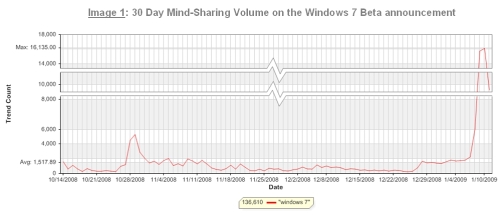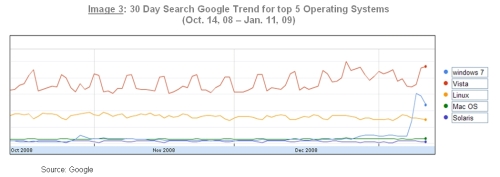For millions of people buying a new car or purchasing a new house are much more expensive but much less threatening than changing an operating system on their PC.
The reason is simple: Cars and houses are much more standardized and reliable than operating systems.
What are the chances of your GPS system not working with the new car or the fridge not operating in the new apartment? And what are the chances of a house or a car being unstable, crashing themselves, turning slow or refusing to operate a new component?
Latest 1st2c study of the online response to the release of Windows 7 Beta in early January 2009 suggests that Social Media fosters a new or at least less acknowledged form of decision making behavior – “Attitude-Forming Impulse Behavior”.
Unlike traditional decision making behavior, Attitude Forming Impulse behavior is not aimed at an imminent purchase but at the forming of a (socially driven) attitude. And unlike despite entailing significant perceived “risk”, this behavior is notably impulsive and refrains from addressing alternatives.
The underlining psychology of “Attitude-Forming Impulse Behavior” offers interesting leverages for marketers in competitive markets.
Windows Beta beats the Oscars
In his keynote on January 8 2008 at the Las-Vegas 2009 CES, Steve Ballmer announced the release of Windows 7 Beta 64-bit version.
Actual sales are said to start only late 2009. The Beta version was addressed primarily at “Registered Microsoft beta peeps”. But that did not prevent huge media coverage and huge surge in online mind sharing.
Actually, as 1st2c monitor shows, the release of Windows 7 Beta version drove at day of announcement more mind-sharing traffic than the last Oscar ceremony.


Interestingly, the buzz on Windows 7 even at this pre-marketing Beta phase does not come exclusively from “Techie” communities. Technology fans and mavens do dominate the discussion (and viewership) but do so in a wide variety of social destinations. These include gaming communities, mobile communication communities, motorcycle and car fan communities, investor communities, etc.
What “Attitude Forming Impulse Behavior” looks like
1st2c identifies three key indicators of consumer engagement in the Social Media space:
· Search
· Talk
· Mobilization
At this early stage in the introduction of new technology the first two come into play.
A quick look at Google search trends for the top 5 operating systems reveals a basic characteristic of impulse behavior – immediate and sharp response.
As image 3 shows, share of search for Windows 7 almost instantly more than quadrupled in reaction to the Windows 7 Beta announcement.

Interestingly, this surge happened despite the fact that information about the imminent announcement was resonating on the market at least two weeks before the announcement and probably accounts for the visible increase in search before the big surge.
It is also noteworthy that besides some increase in search for Windows 7 the predecessor – Vista, interest in all other operating systems remained flat throughout.

One the Talk front, in the Social Media space, consumer response seemed at first glance to be almost identical but does show some significant differences:
· Talk responded to the announcement far more sharply than search
· In Talk (unlike Search) Windows 7 clearly topped the discussion
· While this graph depicts “Mind Sharing” (i.e. volume of posts) traffic in the Social Media space has another critical layer and these are the readers – people who flocked in to read the reviews and discussions but did not author posts or responses themselves.
These and other indicators suggest that Social Media facilitated a second and critical ripple of influence after Corporate Media.
But perhaps more interesting is that behavior on Social Media featured a unique version of impulse behavior – “Attitude-Forming Impulse Behavior”.
This behavior was triggered my marketing, leveraged by mavens and engaged by excited information-hungry users. The uniqueness of this phenomenon is that the massive and instant response was directed at a product that is not “for sale” and has been ignoring alternatives. Massive crowds behaved impulsively… about attitude forming.
In the value-chain of influence, Social Media was the facilitator of “Attitude-Forming Impulse Behavior” playing a critical role in forming the market’s first impression – in this case Windows 7.
Leveraging “Attitude Forming Impulse”
Marketers love to have consumers excited about products that are not even yet on sale. At the same time marketers are also concerned about “wasting ammunition” and creating frustration by exciting consumers about products that are not yet on sale.
In the networked marketplace, internet conditions consumers to shop for information and Social Media conditions them to shop for opinion before shopping for the actual products or services. This behavior seems to contradict impulse shopping.
The Windows 7 Beta case suggests that information and opinion gathering may stand between interest and decision but can also be impulse driven!
Furthermore, Attitude Forming Impulse behavior may be harnessed as a pre-sale tool and may be an effective blocker of competition.
The idea of pepping consumers to learn and talk about a product before it is actually “on the shelves” offers exciting opportunities for marketers is competitive markers. It can actually redefine the whole idea of “Pre-Sale”.
Digital space, both marketer media and social media, offers natural and cost-effective platforms to for such initiatives.
1st2c in a nutshell
1st2c (www.1st2c.com) is the home of Online Strategizing Research©.
1st2c specialized in the most comprehensive data-to-strategy methodology in the networked market.
1st2c monitors all major Social Media platforms and mines consumer dialog and interaction for actionable insights and opportunities.
1st2c works with Fortune 500 companies on adding new dimensions to overall marketing strategy and on monitoring and engaging the networked market.
Ofer Friedman
Chief Research & Client Officer
1st2c
